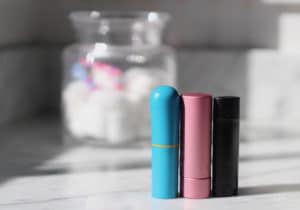 Lip balm moisturizes and protects your lips from drying out, so it’s harmless enough, right? Oh, if only that were true! Unfortunately, toxic ingredients have even found their way into simple products like lip balm. It may be fun to give your daughter a new tube of lip balm that smells like fresh peaches, but what’s really in that stuff? It’s a frustrating fact that the lip balms can contain extremely dangerous ingredients, but it is possible to find a chemical free lip balm that won’t harm your health. Armed with the tips below, you’ll be able to avoid the most common toxic ingredients found in lip balms.
Lip balm moisturizes and protects your lips from drying out, so it’s harmless enough, right? Oh, if only that were true! Unfortunately, toxic ingredients have even found their way into simple products like lip balm. It may be fun to give your daughter a new tube of lip balm that smells like fresh peaches, but what’s really in that stuff? It’s a frustrating fact that the lip balms can contain extremely dangerous ingredients, but it is possible to find a chemical free lip balm that won’t harm your health. Armed with the tips below, you’ll be able to avoid the most common toxic ingredients found in lip balms.
Choosing a Chemical Free Lip Balm: Top 6 Ingredients to Avoid
1. BHA/BHT – BHA (butylated hydroxyanisole) and BHT (butylated hydroxytoluene) are preservatives that are put in a number of cosmetic products. Their purpose is to prevent the growth of harmful bacteria and fungi, which makes them look like the good guys, but BHA and BHT have a dark side too. These chemicals have demonstrated hormone disruption and organ-system toxicity in scientific studies. BHA and BHT have also been shown to cause developmental toxicity, reproductive toxicity, irritation, and cancer. As long as there are chemical free lip balm options available, it’s best to skip the products that contain BHA or BHT.
2. Fragrances – Fragrances seem harmless, particularly when they create scents that signal healthy ingredients like mint, berry or rose. The shocking fact is that the one word “fragrance” on a label can hide a cocktail of hundreds of toxic chemicals that are unregulated. Once these fragrances make contact with your skin, they’re readily absorbed into the bloodstream. Fragrances have been linked with asthma, allergies, hormone disruption, reduced fertility, breast cancer, and immunotoxicity. The ingredients in fragrances don’t have to be listed on ingredient labels because they’re considered to be “trade secrets”. And“natural fragrances” aren’t necessarily safer. Avoid any lip balm with “fragrance” listed in the ingredient label, and double check the ingredients for any that claim to be “unscented”. That’s because many “unscented” products contain fragrances to cover the aversive natural smell of a product.
3. Phthalates – Phthalates are chemicals that are used in fragranced cosmetics including lip balm to make the scent last longer. These toxic chemicals have been shown to cause major health problems like endocrine disruption, developmental toxicity, reproductive toxicity, and cancer, which ultimately led the European Union to ban their use in cosmetics. Despite their dangers, they are widely used in the US. To avoid them, choose a chemical free lip balm that does not have fragrance listed on the label.
4. Parabens – Always read the ingredient label because parabens are widely used in personal care products like lip balm to prevent the growth of bacteria and fungi. Parabens may disrupt the normal functioning of the endocrine system even if you don’t swallow them because these chemicals are easily absorbed through the skin where they enter the blood stream. The US National Health and Nutrition Survey (Nhanes) found parabens in the urine of over 92% of the population tested. detected parabens in almost all Americans tested. Research has shown that parabens can also cause cancer and result in reproductive toxicity. To avoid them, skip any lip balm that has any ingredient ending in -paraben.
5. Octinoxate – One way manufacturers entice consumers to buy a particular lip balm is its ability to shield the lips from the sun. But many lip balm products that provide UV protection also cause endocrine disruption and biochemical and cellular level changes in the body. That’s because they contain octinoxate, a common ingredient in sunscreens that mimics the behavior of hormones in the body. It’s a UV absorber, but it’s also absorbed through the skin into the bloodstream where it can wreak havoc on the body. To avoid this toxic ingredient, skip any lip balms with octinoxate or its synonyms listed on labels: ethylhexyl methoxycinnamte, 2-ethylhexyl p-methoxycinnamate; parsol, parsol mcx, escalol, 2-ethylhexyl p-methoxycinnamate; omc; 2-ethylhexyl 4-methoxycinnamte; 2-ethylhexyl ester p-methoxycinnamic acid; neo heliopan; 2-ethylhexyl 4-methoxycinnamte.
6. Retinyl Palmitate – Retinyl palmitate is commonly used in sunscreens and lip products, but unfortunately it can actually contribute to UV-related sun damage. This ingredient is especially dangerous for children and breastfeeding or pregnant women because it can lead to a potential overdose on vitamin A. To avoid it, skip over any lip balms that contain retinyl palmitate as well as these synonyms on their ingredient lists: vitamin a palmitate; axerophthol palmitate; hexadecanoate retinol; retinol palmitate; retinol, hexadecanoate; aquasol a; arovit; optovit-a; retinol palmitate.
Learn More
To make the switch to a chemical free lip balm, the biggest step you can take is to avoid any products containing the ingredients noted above. You can also use the EWG Skin Deep Cosmetics Database as a tool to research specific ingredients and products across a variety of personal care and cosmetic product types.



